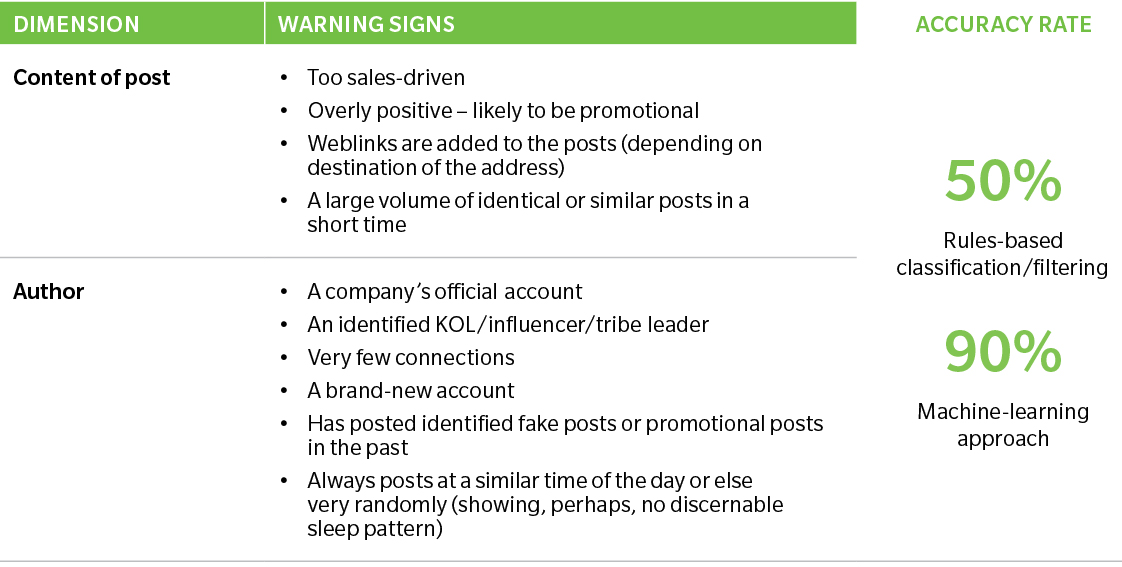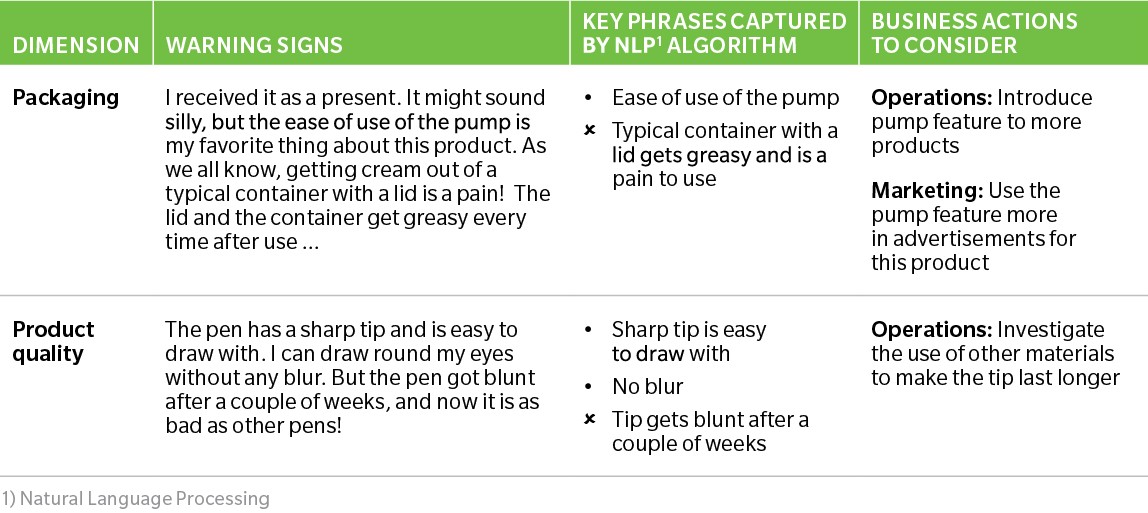Companies have traditionally relied upon consumer surveys, focus groups, and research reports to figure out what people think of their products or services. But these approaches have several shortfalls.
Sample sizes are limited and subject to bias. The studies take time to organize and the results quickly become dated. Moreover, what people say often differs from what they do, like when they complain about discount airlines but then use them all the same.
Social listening provides an alternative that is enabling companies to tap into much richer consumer insights that are generated in real time. Every day, hundreds of millions of people talk publicly on social media about where they have been, what they have bought, and their good and bad experiences. Or they just express their feelings and opinions. This information is a gold mine for consumer-facing industries, including retail, consumer goods, retail banking, insurance, and healthcare. But so far, most companies have not turned this information into value.
In our experience, companies can gain a competitive advantage by analyzing what consumers say on social media because they can obtain better insights at a fraction of the cost and then act on them at lightning speed. Social listening is increasingly informing the new product development, marketing, operations, and international expansion of consumer product companies. It can also aid early crisis management and help spot potential corporate acquisition targets. Put another way, social listening can be turned into the map in a treasure hunt.
Until now, social listening has mostly been limited to public opinion monitoring. For example, it is used to count the number of times a brand is mentioned – “buzz” – and whether the content is positive or negative – “sentiment.” But this monitoring tends to yield only standardized or aggregated metrics, which seldom lead to actionable business decisions.
Recently, advances in machine learning have made smart analysis of natural language content possible, as well as the monitoring of pictures and videos. In our experience, the new techniques have been very effective in enabling companies to investigate a wider range of consumers’ feelings and follow different aspects of their lives. We have seen how their preferences can be mapped and updated immediately, as can the ways in which customers connect with and influence each other.
Machine learning can also overcome the problem of “unclean” data. Companies often buy social media data from a vendor, but many of the source posts do not actually come from consumers; instead, they have been written by the brand’s marketing agency, e-commerce sellers, or robots. In fact, we discovered in one case that more than nine out of 10 posts provided by a data vendor had not actually been written by consumers. Such posts are typically overly positive and give a false impression of a brand’s health. Machine learning can analyze accounts and their content in order to filter out such fake posts (Exhibit 1).
Exhibit 1: What can go wrong when analyzing source posts?

Source: Oliver Wyman analysis
We are only beginning to scratch the surface of how these machine learning advances will enable social listening to eventually rewrite the rules for consumer product companies. But already, we are seeing social listening overturn how consumer product companies develop, market, and package their products. We have seen multiple examples of how social listening can help consumer companies.
GENERATING CONSUMER INSIGHTS
Social listening can uncover hidden links between consumer markets that are heavily influenced by others, as consumers take cultural or fashion cues from places they feel an affinity for. Analysis of social media posts, for example, shows that the Indonesian cosmetics market is now more heavily influenced by trends in Thailand than from France or Japan. It also points to the products and brands concerned, as well as the reasons for the link. For example, one Instagram post about a face powder read: “Best seller in Thailand! Super fit for my skin color.” Another referred to a product’s sun protection factor.
Source: Oliver Wyman analysis
 These comments indicate that Indonesian users of cosmetics see similarities with Thailand in climate and people’s skin color, and that they feel that products popular in Thailand will be right for them. Makeup manufacturers might therefore want to consider taking products that work in Thailand and launching them in Indonesia, perhaps also using their popularity in Thailand as part of an Indonesian marketing campaign. Indeed, in makeup our work suggests that product manufacturers could increase their return on investment in Indonesia by up to 20 percent by identifying and partnering with the most-promising brands in Thailand.
These comments indicate that Indonesian users of cosmetics see similarities with Thailand in climate and people’s skin color, and that they feel that products popular in Thailand will be right for them. Makeup manufacturers might therefore want to consider taking products that work in Thailand and launching them in Indonesia, perhaps also using their popularity in Thailand as part of an Indonesian marketing campaign. Indeed, in makeup our work suggests that product manufacturers could increase their return on investment in Indonesia by up to 20 percent by identifying and partnering with the most-promising brands in Thailand.
We have seen how comments on social media can also help develop new versions of products. For example, a manufacturer can often double its rate of hit products from, say, one in 10 to one in five with better consumer information, halving the cost of developing also-ran products. Social listening thus brings manufacturers closer to consumers, enabling them to make customized, smalllot products for specific groups.
MAKING TRIBAL MARKETING EFFECTIVE
Analysis of social media interactions is also making tribal marketing much easier and more precise, by locating groups with tastes and needs in common on, say, Twitter or Weibo, its Chinese equivalent. By tracking and measuring the connections between a group of new mothers, for example, marketers can map their tribes and identify leaders – the members who are best-connected with the others. These will likely have significant influence on the tribe’s preferences in baby products and other categories they might be drawn to.
Social listening can answer crucial questions about tribe leaders: Do their posts usually get replies? Are they retweeted? Do their photos show them using particular combinations of makeup, accessories, and apparel? In other words, how do the tribe leaders widen interest in the brand? And does the resulting expression of interest lead to retweets and actual purchases? (See Sidebar)
Once tribes with a strong affinity to a product category have been identified, a brand can then build connections with the leaders, for example by sending them exclusive product previews and samples or inviting them to events. The leaders might then turn these into posts, generating interest in their community about the brand and its latest products. These marketing techniques complement mass advertising campaigns with celebrities and key opinion leaders (KOLs) who are paid for their services. This combination of social listening and tribal marketing can generate a return on marketing spend between 20 and 50 percent higher than traditional advertising.
IMPROVING OPERATIONS
Consumers often talk on social media about their interactions and experiences with brands, products, and services – such as how bad the packaging is or how poor the delivery was. However, it is tricky to turn such comments into actions. Simple aggregations of the appearances of key words, such as “packaging,” are not useful, since they don’t indicate whether the specific complaint is leakage or unclear instructions on a bottle. They also won’t help establish whether an issue is confined to a particular batch or is a recurring problem. Without such details, it is impossible to take any action that might improve a manufacturer’s operations (Exhibit 2).
But techniques such as natural language processing, machine learning, and image recognition are now helping to identify more precisely what is being said. They can then suggest the right actions. For example, if one social media post complains that a bottle is hard to carry because it is large and made of glass, that information could prompt a manufacturer to study the potential of smaller bottles made of different materials. If other posts praise some foundation makeup for being long-lasting and hiding pores effectively, these qualities might be considered as themes for future advertisements.
Exhibit 2: Social listening – using posts to improve operations or product innovations

Source: Oliver Wyman analysis
CATCHING TROUBLE EARLY IN LISTED COMPANIES
A less obvious use case for social listening is the early identification of troubled listed companies. Many serious problems – accounting scandals, accumulation of unsustainable debt, and misconduct by senior executives – are preceded by early signs, such as employees talking on social media or in news articles. These might not stand out themselves enough to attract attention at first. But the right techniques can provide clues to help regulators step in and mitigate damage. We have found several examples of accounting scandals, where preceding signs were later identified that could have led to action at an earlier stage.
THE FUTURE OF SOCIAL LISTENING
In practice, these and other social listening use cases will often be combined. A retail bank launching a greenfield digital unit, for instance, can use social listening to identify and quantify customer pain points, segment potential customers, and inform product design. After launch, influencers can be sought out and targeted and the brand perception tracked in order to optimize products and services continuously.
Still, though social listening techniques have been around for over 10 years, very few companies are making the most of them. That’s not because of a lack of material to work with: Publicly available social media data – all of which has been posted with explicit user consent – can be provided by the social media platforms or via third-party data vendors. Instead, the main barrier to making social listening useful has been the quality of the data, which are usually too aggregated to provide significant insight into consumers, or else are based on social postings that include large numbers of fakes. Moreover, obtaining clean data that inform business decisions is not easy. It can require natural language recognition in different languages and advanced techniques to analyze social media accounts and their contents automatically and effectively.
Soon, however, these techniques will be common in consumer-facing industries, and those companies that neglect them will find it hard to catch up. By contrast, product manufacturers that learn how to understand consumers in actionable ways – and to test their reactions in real time – will have a huge advantage.
Typically, we have found, the first step is an audit of the company’s current capabilities – its access to data and the analytics techniques it uses – plus the business value they generate. This takes only a couple of weeks and reveals which new social listening techniques will be most effective and the value they can potentially unleash. The company can then carry out an upgrade, revamping the underlying analytics and developing new business use cases for social listening. This usually takes between three and six months – after which smarter business decisions follow immediately. In our experience, commercial benefits follow in just a few weeks.

